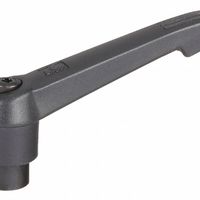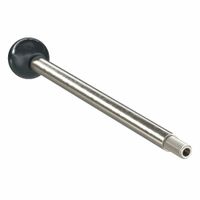Call +(254) 703 030 000 / 751 483 999 / 721 704 777
- Home
- Hardware
- Handles Pulls Knobs
- Machine Handles
.....Read More
Frequently Asked Questions
What are machine handles used for?
Machine handles are used as manual control components on various types of machinery and equipment. They serve several key purposes:
1. **Control and Operation**: Machine handles provide a means for operators to manually control and operate machinery. They allow for the adjustment of machine settings, positioning of components, or activation of specific functions.
2. **Safety and Ergonomics**: Handles are designed to enhance safety and ergonomics. They offer a secure grip, reducing the risk of slippage and potential injury. Ergonomically designed handles minimize strain and fatigue during operation, promoting better posture and comfort for the user.
3. **Precision and Accuracy**: In applications requiring precise control, such as in CNC machines or laboratory equipment, handles allow for fine adjustments. This precision is crucial in tasks that demand high accuracy and repeatability.
4. **Versatility and Adaptability**: Machine handles come in various shapes, sizes, and materials, making them adaptable to different environments and applications. They can be customized to fit specific machine requirements or user preferences.
5. **Durability and Reliability**: Made from robust materials like metal, plastic, or composite, machine handles are designed to withstand harsh industrial conditions. Their durability ensures long-term reliability and consistent performance.
6. **Ease of Use**: Handles simplify the operation of complex machinery by providing intuitive and straightforward control mechanisms. This ease of use is essential for both experienced operators and those with less technical expertise.
7. **Maintenance and Adjustments**: Handles facilitate routine maintenance and adjustments, allowing operators to quickly access and modify machine components without the need for specialized tools.
Overall, machine handles are integral to the efficient, safe, and precise operation of machinery across various industries, enhancing both functionality and user experience.
How do adjustable machine handles work?
Adjustable machine handles, also known as clamping levers or adjustable levers, are mechanical components used to secure, adjust, or release parts on machinery and equipment. They are designed to provide a quick and easy way to apply or release clamping force without the need for additional tools.
The primary components of an adjustable machine handle include a handle, a threaded stud or bolt, and a mechanism that allows for repositioning. The handle is typically made from durable materials such as metal or reinforced plastic, ensuring longevity and resistance to wear.
The key feature of these handles is their ability to be repositioned without affecting the clamping force. This is achieved through a ratcheting mechanism or a serrated insert. When the handle is lifted, it disengages from the serrated insert or ratchet, allowing the user to rotate the handle freely to a more convenient position. Once released, the handle re-engages, allowing the user to apply the necessary torque to tighten or loosen the connection.
Adjustable machine handles are commonly used in applications where space is limited or where frequent adjustments are necessary. They are found in various industries, including manufacturing, automotive, and woodworking, where they are used to secure machine guards, fixtures, or workpieces.
The versatility and ease of use of adjustable machine handles make them an essential component in environments that require frequent adjustments or quick release mechanisms. Their design ensures that users can achieve the desired clamping force while maintaining the ability to reposition the handle for optimal leverage and accessibility.
What is the difference between cam handles and crank handles?
Cam handles and crank handles are both mechanical components used to transmit motion, but they operate differently and serve distinct purposes.
Cam Handles:
- Cam handles use a cam mechanism, which is an irregularly shaped component that rotates or slides to convert rotary motion into linear motion or vice versa.
- The cam profile determines the motion path, allowing for precise control over the movement.
- Cam handles are often used in applications requiring controlled, non-linear motion, such as in machinery for clamping, locking, or adjusting.
- They provide a smooth, gradual motion, which is ideal for applications where sudden movements could cause damage or require precision.
Crank Handles:
- Crank handles use a crank mechanism, which consists of a rotating arm attached to a shaft, converting rotary motion into reciprocating linear motion.
- The crank is typically circular and rotates around a fixed axis, with a connecting rod attached to the crankpin.
- Crank handles are commonly used in applications requiring continuous rotary motion, such as in engines, pumps, or manual winches.
- They are ideal for applications where consistent, repetitive motion is needed, providing mechanical advantage and ease of use.
In summary, cam handles are suited for applications requiring precise, controlled motion, while crank handles are used for applications needing continuous, repetitive motion.
How do lever handles function in machine tools?
Lever handles in machine tools function as manual control devices that facilitate the operation and adjustment of various machine components. They are designed to provide mechanical advantage, allowing operators to exert greater force with less effort. Lever handles are commonly used in machine tools for tasks such as clamping, positioning, and adjusting machine parts.
The basic principle of a lever handle is based on the lever mechanism, which consists of a rigid bar pivoted on a fulcrum. When force is applied to one end of the lever, it results in a greater force being exerted at the other end, depending on the length of the lever arms. This mechanical advantage makes it easier to perform tasks that require significant force or precision.
In machine tools, lever handles are often attached to components like clamps, vises, or slides. For example, in a milling machine, a lever handle might be used to tighten or loosen a workpiece in a vise. The operator can quickly and efficiently secure the workpiece by moving the lever handle, ensuring stability during machining operations.
Lever handles also play a crucial role in adjusting machine settings. For instance, they can be used to control the feed rate or depth of cut in a lathe or milling machine. By moving the lever handle, the operator can make precise adjustments to the machine's operation, enhancing accuracy and efficiency.
Overall, lever handles are essential components in machine tools, providing operators with a simple and effective means of controlling and adjusting various machine functions. Their design leverages the principles of mechanical advantage, making them indispensable in achieving precision and ease of use in machining processes.
What materials are machine handles typically made from?
Machine handles are typically made from a variety of materials, each chosen for its specific properties that suit the intended application. Common materials include:
1. **Metal**: Metals like steel, aluminum, and stainless steel are frequently used for machine handles due to their strength, durability, and resistance to wear and tear. Stainless steel is particularly favored for its corrosion resistance, making it ideal for environments exposed to moisture or chemicals.
2. **Plastic**: Plastics such as polypropylene, nylon, and ABS are popular for their lightweight nature, ease of molding into ergonomic shapes, and cost-effectiveness. They are often used in applications where weight reduction is crucial or where the handle does not need to withstand extreme forces.
3. **Rubber**: Rubber or rubber-coated handles provide excellent grip and comfort, reducing hand fatigue during prolonged use. They are often used in conjunction with metal or plastic cores to combine strength with a comfortable, non-slip surface.
4. **Wood**: Although less common in industrial settings, wood is sometimes used for machine handles in tools or equipment where aesthetics or traditional craftsmanship is valued. Wood handles can be comfortable to grip and provide a natural feel.
5. **Composite Materials**: These are engineered materials made from two or more constituent materials with different physical or chemical properties. Composites can offer a balance of strength, weight, and resistance to environmental factors, making them suitable for specialized applications.
The choice of material depends on factors such as the required strength, environmental conditions, ergonomic considerations, and cost constraints. Each material offers distinct advantages, and the selection is often a compromise between these factors to meet the specific needs of the machine and its users.
How do you install a machine handle on a tool?
1. **Gather Tools and Materials**: Obtain the machine handle, appropriate screws or bolts, a screwdriver or wrench, and any washers or nuts required.
2. **Safety First**: Ensure the machine is turned off and unplugged to prevent accidental activation.
3. **Identify Mounting Location**: Locate the designated area on the tool where the handle will be attached. This is usually pre-drilled or marked.
4. **Align the Handle**: Position the handle over the mounting holes. Ensure it is oriented correctly for comfortable use.
5. **Insert Fasteners**: Place screws or bolts through the handle's mounting holes into the tool's corresponding holes. If washers are needed, place them between the handle and the tool.
6. **Tighten Fasteners**: Use a screwdriver or wrench to tighten the screws or bolts. Ensure they are secure but avoid over-tightening, which can strip threads or damage the tool.
7. **Check Stability**: Gently wiggle the handle to ensure it is firmly attached and does not move.
8. **Test Functionality**: Plug in and turn on the machine to ensure the handle does not interfere with its operation.
9. **Adjust if Necessary**: If the handle is loose or misaligned, loosen the fasteners, adjust the position, and retighten.
10. **Final Inspection**: Confirm that the handle is securely attached and comfortable to use. Make any final adjustments as needed.
What are the benefits of using machine handles for manual adjustments?
Using machine handles for manual adjustments offers several benefits:
1. **Precision and Accuracy**: Machine handles allow for precise control over adjustments, ensuring that changes are made accurately. This is particularly important in settings where even minor deviations can lead to significant issues.
2. **Ergonomics and Safety**: Handles are designed to be ergonomic, reducing strain on the operator. This minimizes the risk of repetitive strain injuries and enhances safety by providing a secure grip, reducing the likelihood of slips or accidents.
3. **Efficiency**: Machine handles enable quick and efficient adjustments. Operators can make changes swiftly without the need for additional tools, saving time and increasing productivity.
4. **Consistency**: Handles provide a standardized method for adjustments, ensuring consistency across different operators and shifts. This uniformity is crucial in maintaining quality and reliability in production processes.
5. **Durability**: Designed to withstand frequent use, machine handles are typically made from robust materials, ensuring longevity and reducing the need for frequent replacements or repairs.
6. **User-Friendly**: Handles are intuitive and easy to use, requiring minimal training. This accessibility allows operators of varying skill levels to perform adjustments confidently.
7. **Versatility**: Machine handles can be used in a wide range of applications and industries, from manufacturing to healthcare, making them a versatile tool for manual adjustments.
8. **Feedback and Control**: Many machine handles provide tactile feedback, allowing operators to feel the adjustment process. This feedback enhances control and helps prevent over-adjustment.
9. **Cost-Effectiveness**: By reducing the need for complex machinery or electronic controls for simple adjustments, machine handles offer a cost-effective solution for many operations.
Overall, machine handles enhance the efficiency, safety, and precision of manual adjustments, making them an invaluable tool in various industrial and commercial settings.



